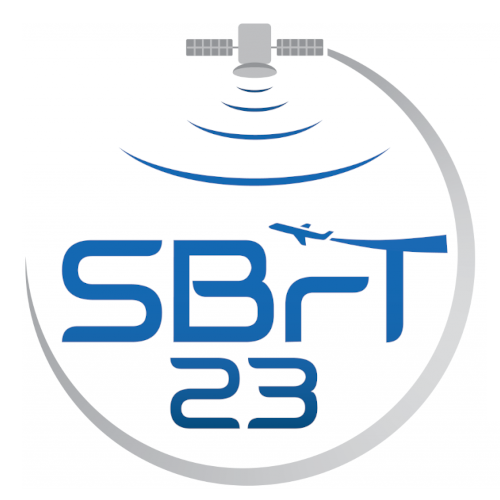
XLI Simpósio Brasileiro de Telecomunicações e Processamento de Sinais

Identificação de AVCi utilizando Extração de Características e uma rede MLP em Imagens de CT
Brenda Jennifer Sousa Nogueira, Emanuel Thiago A. Silva, Luiz Rodrigues, Carlos Danilo Miranda Regis
DOI: 10.14209/sbrt.2023.1570923819
Keywords: Tomografia Computorizada Acidente Vascular Cerebral MLP Redes Neurais
Abstract
Stroke is one of the diseases that causes more deaths and physical disabilities in worldwide. The most common method for identifying regions affected by stroke is the computed tomography(CT) scan. The present study aims identify ischemic stroke, using the Haralick descriptorand an artificial neuralnetwork in the CT images. The best results obtained correspondto an accuracy of 73.42%, sensitivity of 74.86%, precision of72.83%, and F1-score of 73.83%.Download
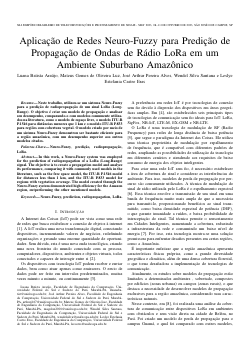
Aplicação de Redes Neuro-Fuzzy para Predição de Propagação de Ondas de Rádio LoRa em um Ambiente Suburbano Amazônico
Luana Batista Araújo, Mateus Gomes de Oliveira Luz, José Arthur Pereira Alves, Wendel Silva Santana, Leslye Castro Eras
DOI: 10.14209/sbrt.2023.1570923820
Keywords: Neuro-Fuzzy Predict Radiopropagation LoRa
Abstract
In this work, a Neuro-Fuzzy system was used to predict the radiopropagation of a LoRa (Long-Range) signal. The objective is to create a propagation model and analyze its performance, comparing it with models commonly used in the literature, such as the free space model, the ITU-R P.1546 model for distances smaller than 1km and the ITU-R P model: 833 for regions with vegetation cover. The neuro-fuzzy system created proved to be very efficient for the Amazon region, with a superior performance than the other mentioned models.Download
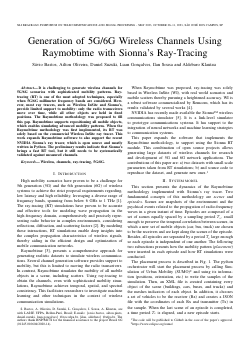
Generation of 5G/6G Wireless Channels Using Raymobtime with Sionna's Ray-Tracing
Sávio Bastos, Ailton P Oliveira, Daniel T. N. N. Suzuki, Luan Assis Gonçalves, Ilan S Correa, Aldebaro Klautau
DOI: 10.14209/sbrt.2023.1570923823
Keywords: Wireless Channels ray-tracing 5G/6G
Abstract
It is challenging to generate wireless channels for 5G/6G scenarios with sophisticated mobility patterns. Ray-tracing (RT) is one of the most adopted techniques, especially when 5G/6G millimeter frequency bands are considered. However, most ray tracers, such as Wireless InSite and Sionna's, provide limited support to mobility: only the radio transceivers move over time, while all other objects are held in fixed positions. The Raymobtime methodology was proposed to fill this gap. Raymobtime supports repositioning all mobile objects, which enables simulating advanced mobility patterns. When the Raymobtime methodology was implemented, RT was solely based on the commercial Wireless InSite ray tracer. This work expands Raymobtime software to also support the recent NVIDIA Sionna's ray tracer, which is open source and mostly written in Python. The preliminary results indicate that Sionna's brings a fast RT tool, but it still needs to be systematically validated against measured channels.Download
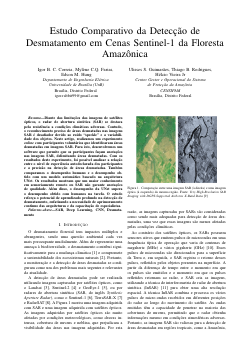
Estudo Comparativo da Detecção de Desmatamento em Cenas Sentinel-1 da Floresta Amazônica
Igor B M C Correia, Mylene Farias, Edson Hung, Ulisses S Guimarães, Hélcio Vieira Jr, Thiago B Rodrigues
DOI: 10.14209/sbrt.2023.1570923825
Keywords: SAR CNN desmatamento estudo
Abstract
Diante das limitações das imagens de satélites óticos, o radar de abertura sintética (SAR) se destaca pela resistência a condições climáticas adversas. Contudo, o reconhecimento preciso de áreas desmatadas nas imagens SAR é desafiador devido ao ruído ``speckle'' e a variabilidade dos objetos. Neste artigo, realizamos um experimento \textit{online} com participantes voluntários que identificaram áreas desmatadas em imagens SAR. Para isto, desenvolvemos um software que permite que os participantes façam anotações na imagens SAR, delimitando áreas desmatadas. Com os resultados deste experimento, foi possível analisar a relação entre o nível de experiência autodeclarada dos participantes e a precisão na detecção de áreas desmatadas. Também comparamos o desempenho humano e o desempenho obtido com um modelo automático baseado na arquitetura UNet. Os resultados mostram que um maior conhecimento em sensoriamento remoto ou SAR não garante anotações de qualidade. O desempenho da UNet supera o desempenho obtido com humanos na tarefa. O estudo reforça o potencial de aprendizado profundo na detecção de desmatamento, enfatizando a necessidade de aprimoramento contínuo das arquiteturas e da capacitação de especialistas.Download
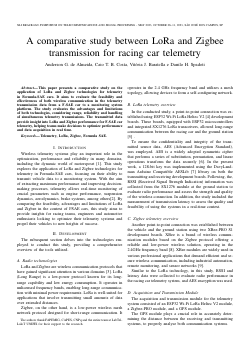
A comparative study between LoRa and Zigbee transmission for racing car telemetry
Anderson Guerra Almeida, Caio Tácito Borges da Costa, Vitória Jacomelli Baratella, Danilo Spadoti
DOI: 10.14209/sbrt.2023.1570923826
Keywords: Telemetry LoRa Zigbee Formula SAE
Abstract
This paper presents a comparative study on the application of LoRa and Zigbee technologies for telemetry in Formula-SAE cars. It aims to evaluate the feasibility and effectiveness of both wireless communication in the telemetry transmission data from a F-SAE car to a monitoring system platform. The study evaluates the advantages and limitations of both technologies, considering range, reliability, power consumption and handling of simultaneous telemetry transmissions. The transmitted data provide insight into LoRa and Zigbee performance for F-SAE car telemetry, helping teams make decisions to optimize performance and data acquisition in real time.Download
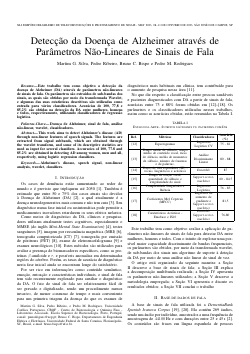
Detecção da Doença de Alzheimer através de Parâmetros Não-Lineares de Sinais de Fala
Martim Silva, Pedro Ribeiro, Bruno C. Bispo, Pedro Miguel Rodrigues
DOI: 10.14209/sbrt.2023.1570923829
Keywords: Doença de Alzheimer sinal de fala análise não-linear classificadores
Abstract
Este trabalho tem como objetivo a detecção da doença de Alzheimer (DA) através de parâmetros não-lineares de sinais de fala. Os parâmetros são extraídos de sub-bandas dos sinais, as quais são obtidas por meio da transformada Wavelet, e algumas das suas estatísticas descritivas são utilizadas como entrada para vários classificadores. Acurácias de 100, 77,8 e 85,2% são obtidas na detecção da DA entre mulheres, homens e todos, respectivamente, utilizando classificadores de regressão logística.Download
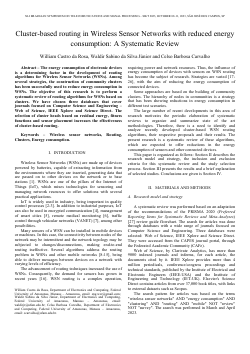
Cluster-based routing in Wireless Sensor Networks with reduced energy consumption: A Systematic Review
William C. da Rosa, Waldir Silva, Celso Carvalho
DOI: 10.14209/sbrt.2023.1570923831
Keywords: Wireless sensor networks Routing Clusters Energy consumpt
Abstract
The energy consumption of devices that form Wireless Sensor Networks is a determining factor in the development of routing algorithms. The objective of this research is to perform a systematic review of algorithms based on clusters, elaborated from Web of Science, IEEE Xplore and Science Direct databases. Sixty articles were approved and ten were selected for an analysis of the effects of clusters in reducing the energy consumption of the network. The selection of cluster heads based on residual energy, fitness functions and sensor placement increases the effectiveness of cluster-based routing.Download
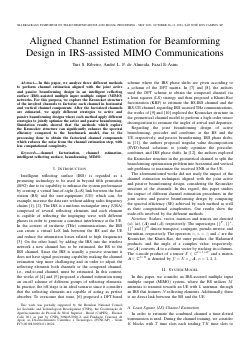
Aligned Channel Estimation for Beamforming Design in IRS-assisted MIMO Communications
Yuri Ribeiro, André de Almeida, Fazal-E- Asim
DOI: 10.14209/sbrt.2023.1570923834
Keywords: channel factorization channel estimation intelligent reflecting surface beamforming
Abstract
In this paper, we analyze three different methods to perform channel estimation aligned with the joint active and passive beamforming design in an intelligent reflecting surface (IRS)-assisted multiple input multiple output (MIMO) networks. For this purpose, we explore the Kronecker structure of the involved channels to factorize each channel in horizontal and vertical channel components. After the factorized channels are estimated, we apply different strategies to active and passive beamforming designs where each method apply different strategies to jointly optimize the active and passive beamforming. Simulation results showed that the methods which explore the Kronecker structure can significantly enhance the spectral efficiency compared to the benchmark model, due to the processing done to obtain the factorized channel components which reduces the noise from the channel estimation step, with less computational complexity.Download
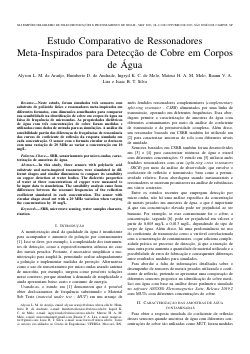
Estudo Comparativo de Ressonadores Meta-Inspirados para Detecção de Cobre em Corpos de Água
Mateus H. A. M. Melo, Alyson L. M. de Araújo, Humberto Dionísio de Andrade, Ingryd K. C. de Melo, Isaac B. T. da Silva, Ruann Lira
DOI: 10.14209/sbrt.2023.1570923835
Keywords: SRR Sensoriamento por micro-ondas Caracterização de amostras de água
Abstract
In this study, the simulated response of sensors in water samples with concentrations of 0 mg/L, 8 mg/L, and 10 mg/L of pure metallic copper powder was observed. Based on the differences in resonance frequencies from the reflection coefficient curves, the sensitivity analysis of the sensors was performed. Three types of sensors were designed with PLA substrate and circular, square, and octagonal SRR shapes, with similar dimensions. The sensor with the circular shape stood out, exhibiting a 20 MHz variation when the concentration was changed by 10 mg/L.Download
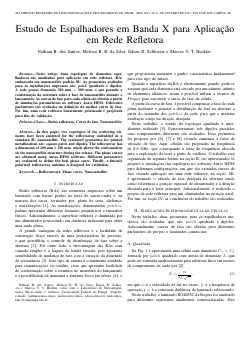
Estudo de Espalhadores em Banda X para Aplicação em Rede Refletora
Nathani Borondi dos Santos, Melissa Bilher, Edson R. Schlosser, Marcos V. T. Heckler
DOI: 10.14209/sbrt.2023.1570923836
Keywords: Redes refletoras Curva de fase Nanossatélite
Abstract
Neste artigo, duas topologias de elementos espalhadores são analisadas para aplicação em rede refletora (RA) embarcada em nanossatélite padrão 8U. As geometrias avaliadas para as metalizações impressas são: patch quadrado e dipolos. A rede possui dimensão 200 mm × 200 mm, o que permite a conformação da estrutura sobre a face do nanossatélite durante o lançamento. As curvas de fase para cada célula são obtidas a partir de simulações paramétricas no software Ansys HFSS. Diferentes parâmetros são avaliados na definição da melhor curva de fase. Por fim, uma rede refletora linearmente polarizada é projetada para fins de validação.Download